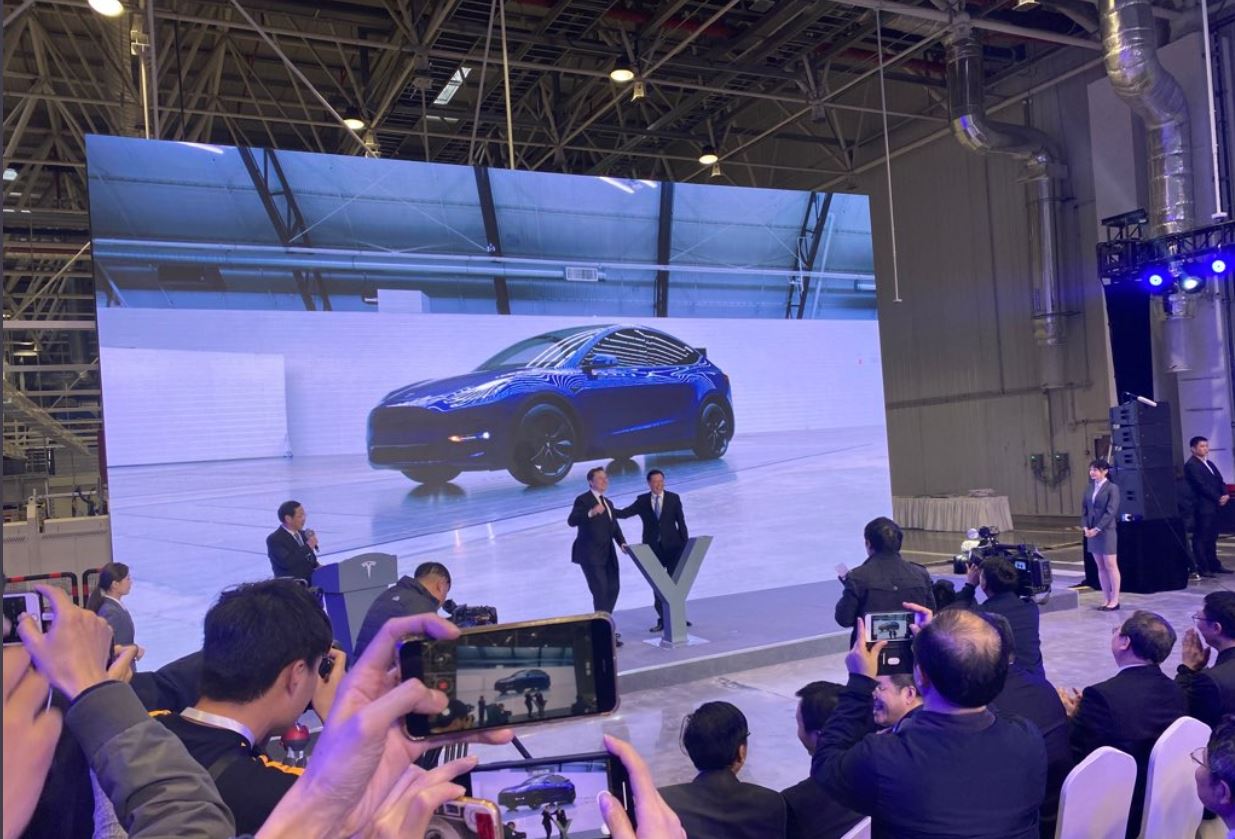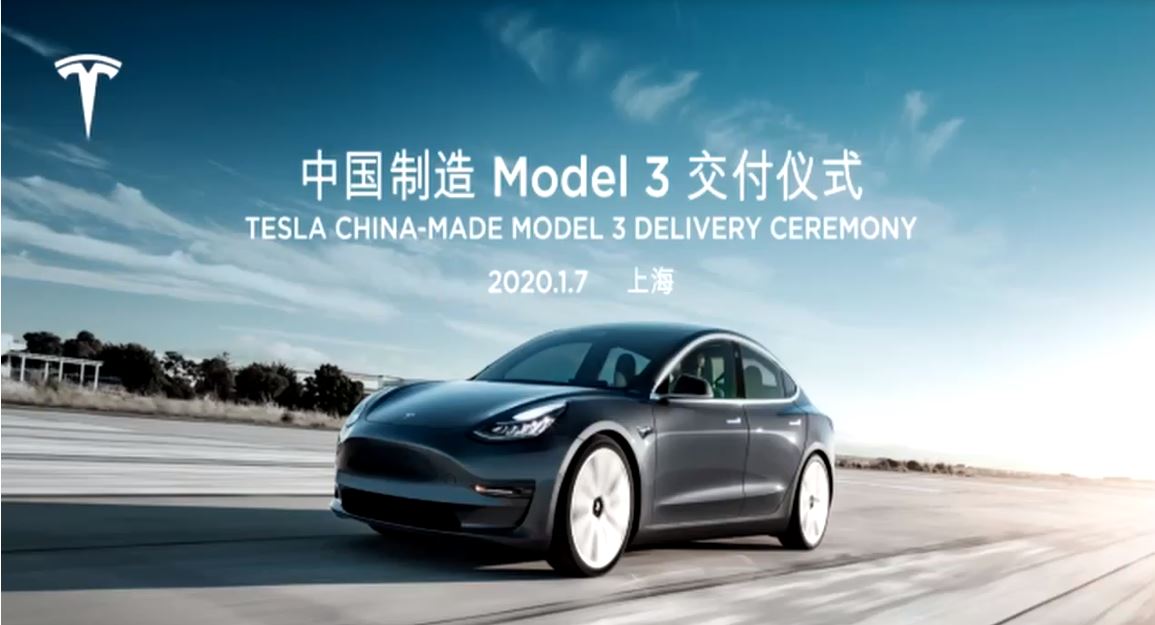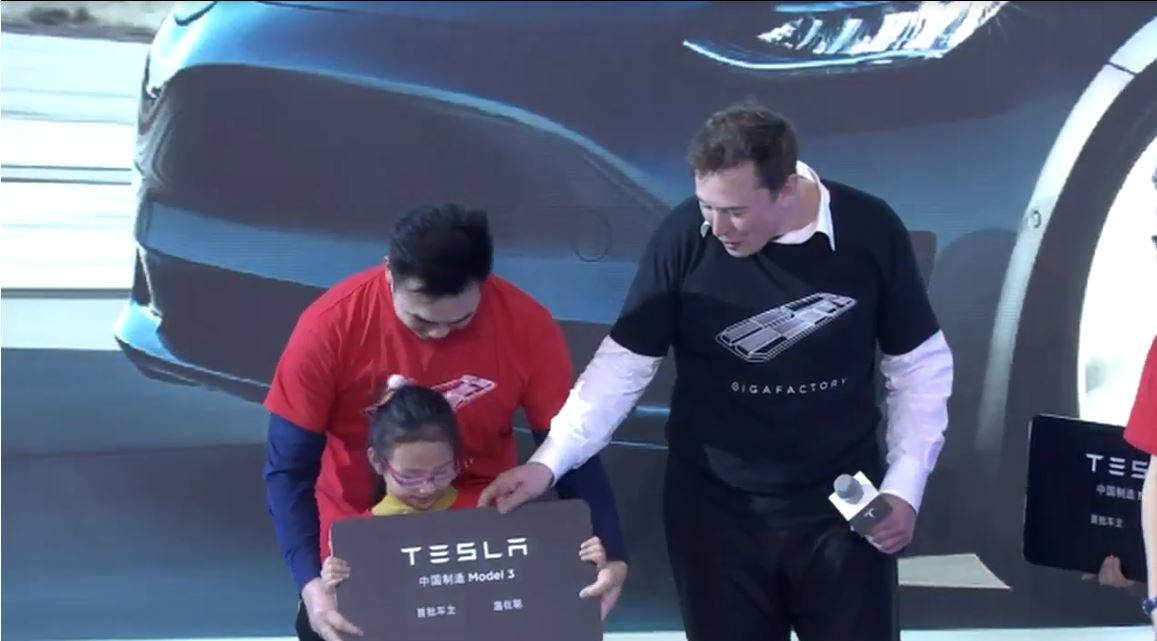

News
Tesla starts Model 3 customer deliveries in China, formally launches Model Y program
Tesla officially opened the floodgates in China as it made its first mass delivery of locally-made Model 3 on Tuesday during an event at Gigafactory 3 in Shanghai. The electric car maker also announced the kick-off of its Model Y program in the country.
CEO Elon Musk flew in from the United States to personally hand over Made-in-China Model 3s to the first local customers. This is a big milestone for Tesla as the MIC Model 3s are the first units delivered by Tesla’s first factory outside of the United States.
“Ultimately Model Y will have more demand than probably all of the other Tesla cars combined. Model Y will also have advanced manufacturing technologies that we will reveal in the future,” Musk said.
Musk also expressed his gratitude to the Chinese government, the Tesla China team, and all of the customers in the country. At one point during the ceremonies, Musk even showed some dance moves and emphasized how the company knows how to have fun despite all the work that needs to be done. Musk also did not forget to thank the early adopters who paid a premium to own their Teslas.
During a speech at the event, the Tesla chief also disclosed plans to have a Tesla engineering center in China that will design vehicles for the local market and the rest of the globe.
With the kick-off of the Model Y program in China, Tesla now has a powerful one-two punch combination that can potentially deal heavy blows to other automotive giants operating in the country. The Model 3 sedans will attract those looking for an entry-level electric vehicle while the Model Y will appeal to those looking for an all-electric crossover that offers more space at a practical price.
Tesla will be facing no pushovers in the local market. Daimler has released the Mercedes-Benz EQC in China and sells it for about $83,100 while Audi has rolled out the e-tron in late 2019 and plans to introduce more green vehicles in the next 24 months. BMW is also planning to join the EV rumble with its iX3 crossover next year.
The first public MIC Model delivery event happened exactly one year after the first wholly-owned car factory by a foreigner in China broke ground. Gigafactory 3 achieved the amazing feat of producing its first vehicles in just 10 months and making a symbolic delivery to local Tesla employees before the end of 2019.
Meanwhile, the production of the Model Y alongside the Model 3 will not be an issue for Tesla since these vehicles share 75% of their parts. Tesla also started accepting Model Y orders a few days ago, an early indication that the electric car maker is ready for this move.
Earlier this week, Tesla confirmed that Gigafactory 3 has achieved a run-rate of 3,000 vehicles per week to meet Model 3 demand in China. The government has also been very supportive and has exempted the locally-made sedan from a 10% purchase tax as announced recently.
Shanghai-based analysts are optimistic with their forecast for Tesla in China. Managing director of consultancy firm AutoForesight Yale Zhang sees the Palo Alto, California-based electric vehicle manufacturer selling around 100,000 MIC Model 3s while China International Capital’s Wang Lei sees around 120,000 combined sales of Model 3 and Model Y.
With the Model 3 and Model Y entering the largest automotive market in the globe, Tesla can become a strong foothold for the brand as it aims to achieve sustained profitability.
Here’s are some snapshots from the event:





News
Tesla Insurance officially expands to new U.S. state
Tesla’s in-house Insurance program first launched back in late 2019, offering a new way to insure the vehicles that was potentially less expensive and could alleviate a lot of the issues people had with claims, as the company could assess and repair the damage itself.

Tesla Insurance has officially expanded to a new U.S. state, its thirteenth since its launch in 2019.
Tesla has confirmed that its in-house Insurance program has officially made its way to Florida, just two months after the company filed to update its Private Passenger Auto program in the state. It had tried to offer its insurance program to drivers in the state back in 2022, but its launch did not happen.
Instead, Tesla refiled the paperwork back in mid-October, which essentially was the move toward initiating the offering this month.
BREAKING: Tesla Insurance has just officially launched in Florida.
This is the first new state to receive @Tesla Insurance in more than 3 years. In total, Tesla insurance is now available in 13 U.S. states (map in thread below of all the states).
Tesla Insurance in Florida uses… pic.twitter.com/bDwh1IV6gD
— Sawyer Merritt (@SawyerMerritt) December 17, 2025
Tesla’s in-house Insurance program first launched back in late 2019, offering a new way to insure the vehicles that was potentially less expensive and could alleviate a lot of the issues people had with claims, as the company could assess and repair the damage itself.
It has expanded to new states since 2019, but Florida presents a particularly interesting challenge for Tesla, as the company’s entry into the state is particularly noteworthy given its unique insurance landscape, characterized by high premiums due to frequent natural disasters, dense traffic, and a no-fault system.
Annual average premiums for Florida drivers hover around $4,000 per year, well above the national average. Tesla’s insurance program could disrupt this, especially for EV enthusiasts. The state’s growing EV adoption, fueled by incentives and infrastructure development, aligns perfectly with Tesla’s ecosystem.
Moreover, there are more ways to have cars repaired, and features like comprehensive coverage for battery damage and roadside assistance tailored to EVs address those common painpoints that owners have.
However, there are some challenges that still remain. Florida’s susceptibility to hurricanes raises questions about how Tesla will handle claims during disasters.
Looking ahead, Tesla’s expansion of its insurance program signals the company’s ambition to continue vertically integrating its services, including coverage of its vehicles. Reducing dependency on third-party insurers only makes things simpler for the company’s automotive division, as well as for its customers.
News
Tesla Full Self-Driving gets sparkling review from South Korean politician
“Having already ridden in an unmanned robotaxi, the novelty wasn’t as strong for me, but it drives just as well as most people do. It already feels like a completed technology, which gives me a lot to think about.”

Tesla Full Self-Driving got its first sparkling review from South Korean politician Lee So-young, a member of the country’s National Assembly, earlier this week.
Lee is a member of the Strategy and Finance Committee in South Korea and is a proponent of sustainable technologies and their applications in both residential and commercial settings. For the first time, Lee was able to utilize Tesla’s Full Self-Driving technology as it launched in the country in late November.
Her thoughts on the suite were complimentary to the suite, stating that “it drives just as well as most people do,” and that “it already feels like a completed technology.”
드디어 오늘, 서울에서 테슬라 FSD 체험 했습니다.
JiDal Papa님의 모델S 협찬에 힘입어^^ 파파님 정말 감사합니다.
국회 -> 망원시장 -> 홍익대 -> 국회 복귀 코스였고요.
이미 무인 로보택시를 타봐서 그런지 신기함은
덜했지만, 웬만한 사람만큼 운전을 잘하네요.이미 완성된 기술이라고… pic.twitter.com/8pAidHBpRG
— 이소영 국회의원 (Soyoung Lee) (@im_soyounglee) December 17, 2025
Her translated post says:
“Finally, today I got to experience Tesla FSD in Seoul. Thanks to the Model S sponsored by JiDal Papa^^, I’m truly grateful to Papa. The route was from the National Assembly -> Mangwon Market -> Hongik University -> back to the National Assembly. Having already ridden in an unmanned robotaxi, the novelty wasn’t as strong for me, but it drives just as well as most people do. It already feels like a completed technology, which gives me a lot to think about. Once it actually spreads into widespread use, I feel like our daily lives are going to change a lot. Even I, with my license gathering dust in a drawer, don’t see much reason to learn to drive a manual anymore.”
Tesla Full Self-Driving officially landed in South Korea in late November, with the initial launch being one of Tesla’s most recent, v14.1.4.
It marked the seventh country in which Tesla was able to enable the driver assistance suite, following the United States, Puerto Rico, Canada, China, Mexico, Australia, and New Zealand.
It is important to see politicians and figures in power try new technologies, especially ones that are widely popular in other regions of the world and could potentially revolutionize how people travel globally.
News
Tesla dispels reports of ‘sales suspension’ in California
“This was a “consumer protection” order about the use of the term “Autopilot” in a case where not one single customer came forward to say there’s a problem.
Sales in California will continue uninterrupted.”

Tesla has dispelled reports that it is facing a thirty-day sales suspension in California after the state’s Department of Motor Vehicles (DMV) issued a penalty to the company after a judge ruled it “misled consumers about its driver-assistance technology.”
On Tuesday, Bloomberg reported that the California DMV was planning to adopt the penalty but decided to put it on ice for ninety days, giving Tesla an opportunity to “come into compliance.”
Tesla enters interesting situation with Full Self-Driving in California
Tesla responded to the report on Tuesday evening, after it came out, stating that this was a “consumer protection” order that was brought up over its use of the term “Autopilot.”
The company said “not one single customer came forward to say there’s a problem,” yet a judge and the DMV determined it was, so they want to apply the penalty if Tesla doesn’t oblige.
However, Tesla said that its sales operations in California “will continue uninterrupted.”
It confirmed this in an X post on Tuesday night:
This was a “consumer protection” order about the use of the term “Autopilot” in a case where not one single customer came forward to say there’s a problem.
Sales in California will continue uninterrupted.
— Tesla North America (@tesla_na) December 17, 2025
The report and the decision by the DMV and Judge involved sparked outrage from the Tesla community, who stated that it should do its best to get out of California.
One X post said California “didn’t deserve” what Tesla had done for it in terms of employment, engineering, and innovation.
Tesla has used Autopilot and Full Self-Driving for years, but it did add the term “(Supervised)” to the end of the FSD suite earlier this year, potentially aiming to protect itself from instances like this one.
This is the first primary dispute over the terminology of Full Self-Driving, but it has undergone some scrutiny at the federal level, as some government officials have claimed the suite has “deceptive” naming. Previous Transportation Secretary Pete Buttigieg was vocally critical of the use of the name “Full Self-Driving,” as well as “Autopilot.”








